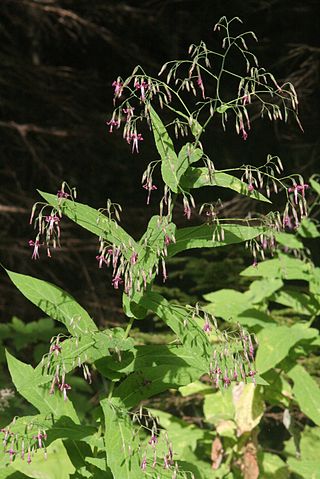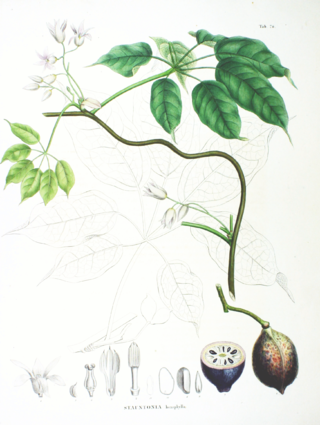
Echinacea is a genus of herbaceous flowering plants in the daisy family. It has ten species, which are commonly called coneflowers. They are native only in eastern and central North America, where they grow in wet to dry prairies and open wooded areas. They have large, showy heads of composite flowers, blooming in summer. The generic name is derived from the Greek word ἐχῖνος, meaning "hedgehog", due to the spiny central disk. These flowering plants and their parts have different uses. Some species are cultivated in gardens for their showy flowers. Two of the species, E. tennesseensis and E. laevigata, were formerly listed in the United States as endangered species; E. tennesseensis has been delisted due to recovery and E. laevigata is now listed as threatened.

Digitalis purpurea, the foxglove or common foxglove, is a toxic species of flowering plant in the plantain family Plantaginaceae, native to and widespread throughout most of temperate Europe. It has also naturalized in parts of North America, as well as some other temperate regions. The plant is a popular garden subject, with many cultivars available. It is the original source of the heart medicine digoxin. This biennial plant grows as a rosette of leaves in the first year after sowing, before flowering and then dying in the second year. It generally produces enough seeds so that new plants will continue to grow in a garden setting.

Sarracenia purpurea, the purple pitcher plant, northern pitcher plant, turtle socks, or side-saddle flower, is a carnivorous plant in the family Sarraceniaceae.

Prenanthes is a genus of plant in the family Asteraceae, often referred to as rattlesnake root.

Echinacea purpurea, the eastern purple coneflower, purple coneflower, hedgehog coneflower, or echinacea, is a North American species of flowering plant in the family Asteraceae. It is native to parts of eastern North America and present to some extent in the wild in much of the eastern, southeastern and midwestern United States as well as in the Canadian Province of Ontario. It is most common in the Ozarks and in the Mississippi/Ohio Valley. Its habitats include dry open woods, prairies and barrens.

Stauntonia is a genus of flowering plants in the family Lardizabalaceae. It is named after George Staunton, who brought it to Britain from China in the 19th century.
Etlingera purpurea is a monocotyledonous plant species that was first described by Adolph Daniel Edward Elmer, and given its current name from Axel Dalberg Poulsen. Etlingera purpurea is part of the genus Etlingera and the family Zingiberaceae. No subspecies are listed in the Catalog of Life.

Stauntonia hexaphylla or Stauntonia vine is a plant in the family Lardizabalaceae.

Stauntonia chinensis is a plant in the family Lardizabalaceae. It is endemic to China, where it is distributed in Yunnan, Guangxi, Guangdong, Zhejiang, Jiangxi, Fujian, Hunan, Anhui, Hong Kong, Guizhou and other places. It grows at an altitude of 500 meters to 1,300 meters above sea level and can be found in dense forests in mountainous areas, thickets on the hillside or sparse forests along the streams in valleys.
Stauntonia trinervia is a plant in the family Lardizabalaceae. It is distributed in Guangdong and other parts of mainland China, and grows at an altitude of 350 to 500 meters above sea level in open forests beside water in valleys.
Stauntonia obovata is a plant in the family Lardizabalaceae. It is distributed in Taiwan and mainland China in Guangdong, Sichuan, Fujian, Guangxi, Jiangxi, Hong Kong, Hunan and other places. It grows in areas with an altitude of 300 to 800 meters, mostly in open forests or dense forests in mountain valleys.
Stauntonia brunoniana is a plant in the family Lardizabalaceae. It is distributed in Vietnam, India, Myanmar, and Yunnan in mainland China, and grows at an altitude of 900 to 1,500 meters above sea level, generally in mountain forests.
Stauntonia brachyandra is a plant in the family Lardizabalaceae.
Stauntonia cavalerieana is a plant in the family Lardizabalaceae. It is endemic to China.
Stauntonia yaoshanensis is a species of flowering plant in the family Lardizabalaceae. Its native range is Guangxi and other provinces of southeast China. It is a climber and grows primarily in the subtropical biome.
Stauntonia grandiflora is a plant in the family Lardizabalaceae. The native range of this species is South-Central China to Vietnam. It is a climber and grows primarily in the temperate biome.
Stauntonia chapaensis is a plant in the family Lardizabalaceae. The native range of this species is China to Vietnam. It is a liana and grows primarily in the subtropical biome.
Stauntonia conspicua is a plant in the family Lardizabalaceae. It is endemic to China, distributed in Zhejiang Province in mainland China. It grows at an altitude of 1,300 to 1,600 meters above sea level, often in dense forests on mountain slopes.
Stauntonia crassifolia is a plant in the family Lardizabalaceae. The native range of this species is Myanmar. It is a subshrub and grows primarily in the subtropical biome.
Stauntonia maculata is a plant in the family Lardizabalaceae. The native range of this species is China. It is a climber and grows primarily in the subtropical biome, at an altitude of 600 to 1,000 meters above sea level. It is mostly found in open forests in mountainous areas or in sunny places beside streams in valleys.







